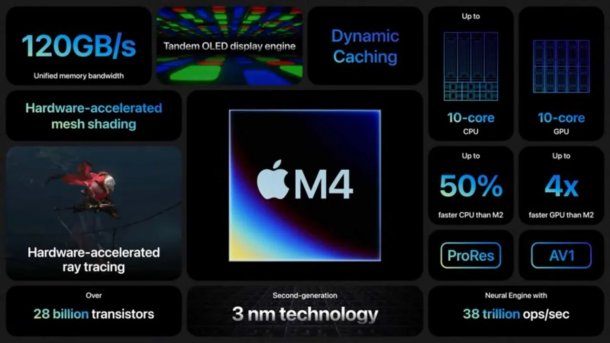New Apple M4 chip debuts in the iPad Pro
Just six months after the M3, Apple is already pushing out the next generation of its SoC in the iPad Pro.

Not that the M2 processors in the previous iPad Pro were slow, but Apple obviously wanted to go one better: With the new iPad Pro, the manufacturer is skipping a chip generation and relying on the "M4". Until now, the new chips have always debuted in the MacBook Pro.
Like the M3 and M2, the M4 has four performance cores, but now six instead of four efficiency cores. Apple has probably further increased the clock rates of both, but is keeping quiet about this as usual. The number of graphics cores did not increase compared to the M2 or M3 and remained at 10.
Compared to the M3, the memory bandwidth increased from 102 to 120 GByte/s, the number of transistors from 25 to 28 billion and the number of teraops of the Neural Engine for local AI calculations from 18 to 38.
| Comparison of Apple SoCs | ||||
| SoC | M1 | M2 | M3 | M4 |
| Max. CPU Cores | 4 P + 4 E | 4 P + 4 E | 4 P + 4 E | 4 P + 6 E |
| P-Core Clock (GHz) | 3.2 | 3.5 | 4.1 | TBD |
| E-Core Clock (GHz) | 2.1 | 2.4 | 2.7 | TBD |
| Max. GPU Cores | 8 | 10 | 10 | 10 |
| GPU Shaders | 1024 | 1280 | 1280 | TBD |
| Max. Monitors | 2 | 2 | 2 | TBD |
| Transistors (billion) | 16 | 20 | 25 | 28 |
| Manufacturing (nm) | TSMC 5 nm | TSMC 5 nm | TSMC 3 nm | TSMC 3 nm |
| L2 Cache (MB) | 12 + 4 | 16 + 4 | N/A | N/A |
| SL Cache (MB) | 16 | 16 | N/A | N/A |
| AI Cores (teraops) | 16 with 11 | 16 with 15.8 | 16 with 18 | 16 with 38 |
| RAM Type / Data Lines | LPDDR4X-4266 / 128 Bit | LPDDR5-6400 / 128 Bit | LPDDR5-6400 / 128 Bit | TBD |
| RAM Transfer Rate (GB/s) | 68 | 102 | 102 | 120 |
| Max. RAM | 16 GB (2x8) | 24 GB (2x12) | 24 GB (2x12) | TBD |
| P = Performance Core, E = Efficiency Core | ||||
(jes)